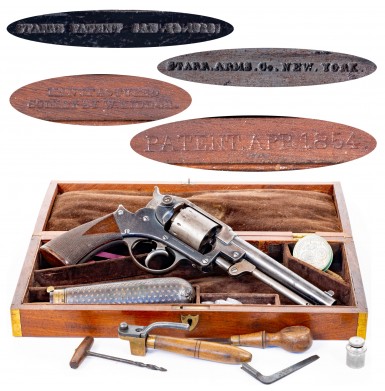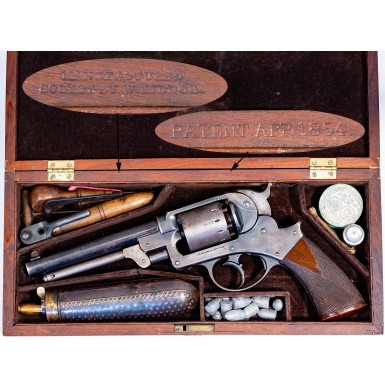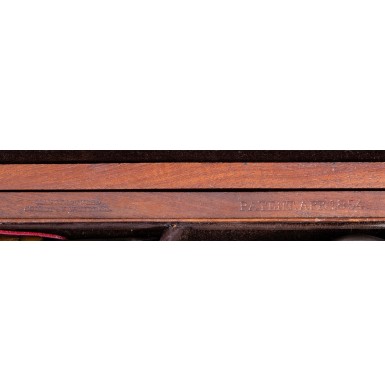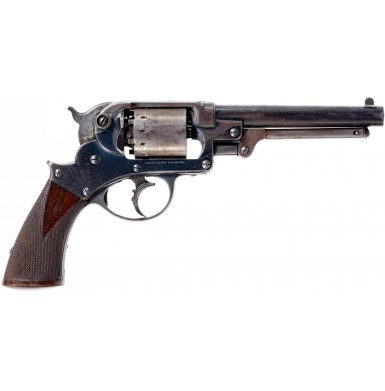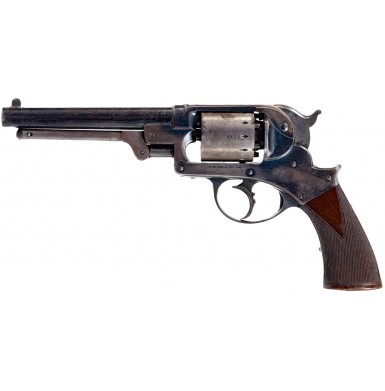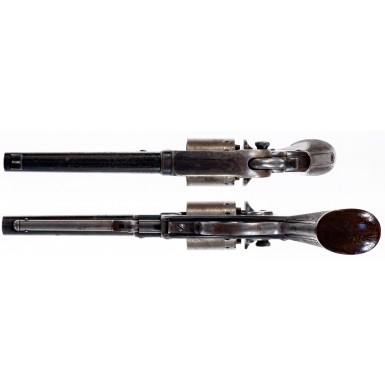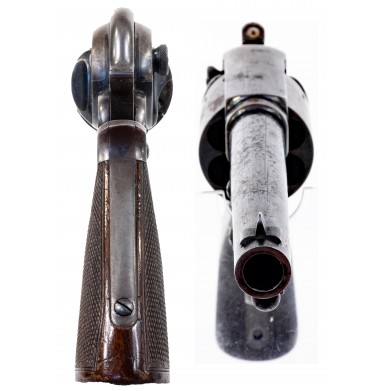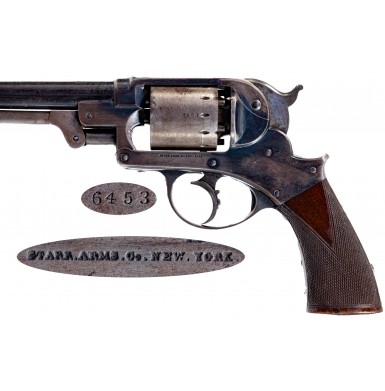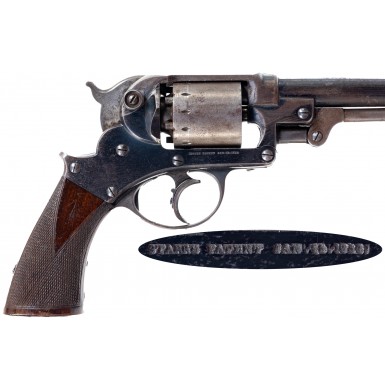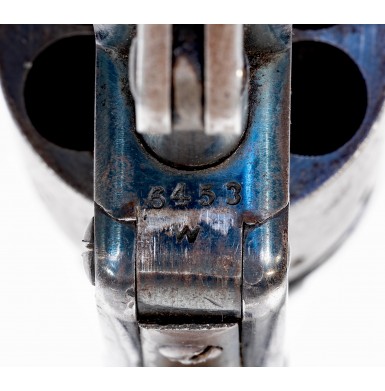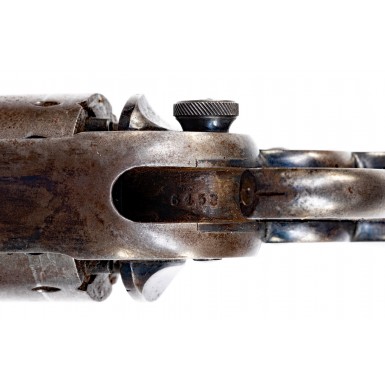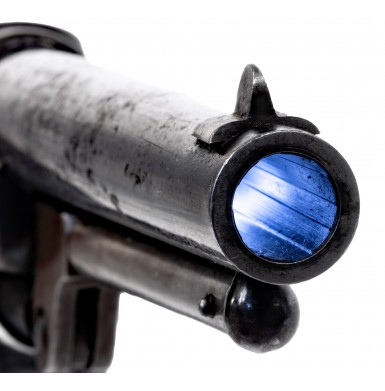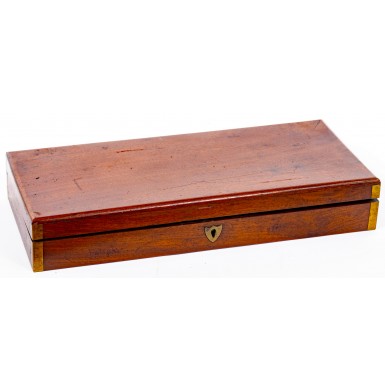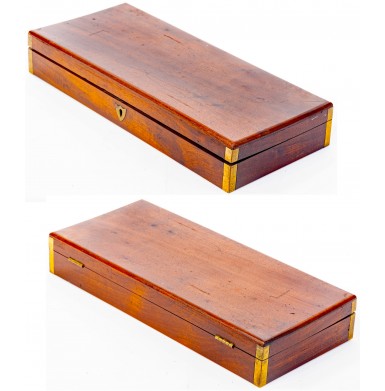Rare & Fine Kidder Patent Cased Civilian Starr Model 1858 Double Action Army Revolver
- Product Code: FHG-3523
- Availability: In Stock
-
$6,500.00
This is a FINE condition example of a rarely encountered retailer cased civilian Starr Model 1858 Double Action Army .44 Caliber Percussion Revolver in a rare Kidder Patent Casing. While the design was innovative for its time, the self-cocking mechanism was delicate and expensive and led to the Starr company dropping the model in preference of a cheaper and more robust single action design, the Model 1863. Although referred to as a “double action” revolver, the action was not quite like a modern double action design and in some way was more like a Tranter “double trigger” revolver. Pulling the trigger did lift the hammer and rotate the cylinder to index it for the next shot, but the trigger could be released after the cylinder was indexed and the hammer was cocked and left in a cocked and ready to fire position. The firing of the revolver was then performed by depressing the exposed sear lever that projected from the frame at the rear of the triggerguard. This could be done by either pushing the lever like a trigger or by pulling the trigger fully to the rear, where a sliding adjustable plate on the rear face of the trigger would depress the sear lever and release the hammer. By sliding the plate slightly upwards or downwards the revolver could be set to only be cocked and indexed by pulling the trigger or to be fired as well.
The Starr Model 1858 Army revolver was a six-chambered, .44 caliber percussion revolver with a 6” round barrel. The .44 caliber “Army” variant of the revolver was produced from 1861 through 1863, when production of the Model 1863 superseded the Model 1858. Starr was the third largest provider of revolvers to the US government during the course of the American Civil War, with only Colt and Remington delivering more handguns. The Starr Model 1858 saw significant service with the US military during the Civil War. The initial US government purchases of Model 1858 revolvers were made by the Navy, who purchased the .36 caliber version of the pistol. Army procurements were initiated in the summer of 1861, with the first revolvers being delivered in January of 1862. Over a three-year period, Starr delivered 21,050 of their Model 1858 revolvers, with 9,900 accepted in 1862, 6,200 in 1863 and 4,950 in 1864. The guns saw use with more than 40 different US mounted regiments, including in part the 1st Arkansas Cavalry, 2ndCalifornia Cavalry, 1st, 2nd & 3rd Colorado Cavalry, 10th, 13th & 16th Illinois Cavalry, 2nd, 3rd & 5th Indiana Cavalry, 5th, 8th, 11th & 12th Kentucky Cavalry, 11th & 12th New York Cavalry, 2nd & 4th Ohio Cavalry, 2nd – 8th Missouri State Militia Cavalry, 13th Tennessee Cavalry, 1st & 2nd Tennessee Mounted Infantry, and 1st Wisconsin Cavalry.
The revolvers received mixed reports from the men that used them in the field, with one of the most damning comments coming from an officer with the 12th Kentucky Cavalry, who noted:
“The man who sold these pistols to the government and the contractor who bought them ought to be hanged as traitors.”
Even though the guns were procured at prices that ranged from about $23 to $25 per pistol during the war, the guns were of limited value at the end of the war. Between October of 1865 and June of 1868, the US government disposed of some 2,026 .44 Starr revolvers at prices that varied from $2.87 to $5.00 each. In December of 1870 some 20,000 .44 Starr revolvers (both single and double action) were sold to the Austin Baldwin Company for $8.00 each, and on 19 June 1901 the Francis Bannerman Company purchased the last 7,537 .44 Starr revolvers in US governments stores, at between 2.13 cents and 27.55 cents each, a far cry from the $23 to $25 per gun prices that were paid by the government during the war.
While the large majority of the roughly 23,000 Starr Model 1858 revolvers were produced were acquired by the US military, about 10% of the production was sold on the commercial market. These guns were sometimes offered for sale by retailers like Schuyler, Hartley & Graham, with upgraded grips, decorative engraving and in accessorized cased set. However, such purely commercial Starr Model 1858 Revolvers are quite scarce, particularly period cased examples.
Offered here is a FINE condition example of one of those rare, Cased Civilian Starr Model 1858 Army Revolver. Unlike its military brethren, the revolver is devoid of inspection markings and cartouches, and instead sports a lovely set of checkered one-piece walnut grips. The revolver is serial numbered 6453 and the matching numbers are found on the lower front of the frame, in hammer cut out in the upper rear of the frame, on the inside face of the hammer neck and on the side of the cylinder. The revolver is additionally marked
STARR.ARMS.Co. NEW.YORK.
on the left side of the frame, below the cylinder and
STARR’S PATENT JAN. 15. 1856
on the right side of the fame, below the cylinder.
The gun retains about 60%+ of its original bright blue overall. These guns are notorious for the finish flaking, leaving many of the surviving examples of these guns with dull pewter gray metal appearance. The revolver retains the majority of its blue on the barrel, and on the right side of the frame with less blue on the left side of the frame. The cylinder retains no finish and has moderately oxidized brownish-gray patina. The color casehardened loading lever and hammer have both faded and dulled to a mostly smoky gray patina with some traces of mottled color on the hammer. The metal of the revolver is mostly smooth with some freckled areas of oxidized surface roughness scattered along the barrel, as well as some small areas of minor pinpricking and some small areas of minor surface roughness here and there. The cylinder shows the largest patches of surface roughens, with one spot roughly thumb print sized. The action of the revolver is very crisp and works perfectly. The gun is mechanically tight and times, indexes and locks up exactly as it should. Sliding the selector at the rear of the trigger allows the revolver’s trigger to work in traditional double action mode or simply as a cocking lever, leaving the gun ready to fire with the hammer cocked. The bore of the revolver is in about FINE condition. It is mostly bright with some scattered patches of oxidized surface roughness. The bore retains crisp rifling and shows some lightly scattered light pitting here and there. All of the percussion cones (nipples) are all in very good condition as well. The cylinder chambers remain fairly crisp with some traces of blue on their interiors. The screws are in nice condition and show only some light slot wear, with some of the heads retaining traces of blue. The one-piece oil finished wood grip is in FINE condition as well. It remains solid and complete with no breaks, cracks, chips, or repairs but shows moderate wear. As noted, the grip is finely checkered, a feature not found on the military revolvers, which had smooth grips. The grip shows some very lightly scattered minor bumps, dings, and handling marks and retains fairly crisp checkering.
The revolver is contained in a scare and FINE condition Kidder Patent compartmentalized case, no doubt added by a retailer like Schuyler, Hartley & Graham. The mahogany case has metal reinforcement connectors that join the mortised sidewall edges of the case, as is typical of a Kidder patent case. The top rear edge of the case is stamped in two locations, the first in two lines:
MANUFACTURED
SOLEY BY W KIDDER
and then in a larger single line:
PATENT APR. 1854
The date references inventor Ari Davis’s US Patent #10780, granted on 18 April 1854 for a machine that could produce wooden boxes with metal reinforced corner joints. Walter Kidder purchased the patent rights from Davis to produce cases under this patent for the use of firearms retailers and manufacturers.
However, Kidder also used the patent to produce boxes for other devices. Kidder was a doctor from Lowell, MA and another of his ventures was the manufacture of a quack medical device known as the Davis & Kidder Patent Magneto-Electric Machine for Nervous Diseases. This was one of the early electric shock therapy devices intended to cure mental and neurological problems, and as would be expected, it was of no use for either. Interestingly this device had also been patented by Davis in 1854 and it is reported that Kidder procured both sets of patent rights from Davis for the somewhat substantial sum of $4,000. It is possible that the manufacturing of firearms cases by Kidder was a secondary business as the manufactory had already been established to produce the electrical medical device. Selling gun cases likely helped to underwrite the cost of producing the medical devices. Kidder patent cases are most often associated with very high-end factory engraved Colt revolvers, but it is not clear if Colt acquired the cases for use with these highly embellished guns or if they were added by the retailer.
As is typical of Kidder cases, the interior lining is dark brown velvet with a heavily padded pillow in the lid. The case is lockable, and the lock has a brass shield shaped escutcheon in the front face. The key still accompanies the casing and the lock still functions. The casing includes a full set of accouterments for the loading and maintenance of the gun. These include:
1) An unmarked James Dixon & Sons “Stars” pattern flask of the correct size and type for a gun of this size, decorated with an embossed star and circle pattern that retains much of its varnish and is in FINE condition.
2) A Starr .44 caliber brass block, wooden handle single cavity bullet mold that also remains in FINE condition.
3) A FINE condition Starr L-shaped combination tool which serves as a cone wrench and screwdriver.
4) A wooden handled turnscrew that may or may not be an original part of the set of tools included with the revolver, but certainly of the period. It remains in VERY GOOD condition.
5) A small pewter oil container with detail oiler attached to the lid, which remains in FINE condition as well.
6) A paper container of Goldmark percussion caps dated 1858. The container remains in VERY GOOD+ condition.
7) Thirteen .44 caliber conical Starr bullets in VERY GOOD condition. They show moderate surface oxidation and good age.
8) A VERY GOOD small wooden T-handle auger style tool that appears to be of the period, but which may or may not be part of the original set of accessories for the revolver.
The case itself remains in about FINE condition with some minor warping to the lid and moderate wear to the interior. The exterior of the case shows the expected scattered minor dings, mars and handling marks. There is some moderate wear and loss to the lining of the interior, particularly where the hammer spur and cylinder have rubbed the casing over the years. The dividers remain in good condition and are fairly stable but like all case dividers are somewhat fragile and weak and the revolver should not be transported in the case as it could easily break one of the dividers. Interestingly there are some shadows of the original divider locations in the bottom of the case, indicating that this case was originally intended for a different gun, probably a Colt Navy and the retailer reconfigured the case to use it with the Starr Army revolver.
Overall, this is a really lovely condition example of a rare civilian Starr Model 1858 Revolver in a very scarce and completely correct retailer provided Kidder patent casing. The gun is accompanied by a nice set of period accoutrements and accessories that are mostly correct for the gun and most of which appear to have been with it since the period of use. The gun remains in fine condition overall and is fully functional and the casing is in equally fine condition. Rarely do these retailer cased civilian Starr revolvers appear on the market and this is a lovely correct example in very nice condition that displays wonderfully and has tons of eye appeal. This will be a great addition to any advanced collection of Civil War era percussion revolvers, and I know you will be proud to own and display it.

